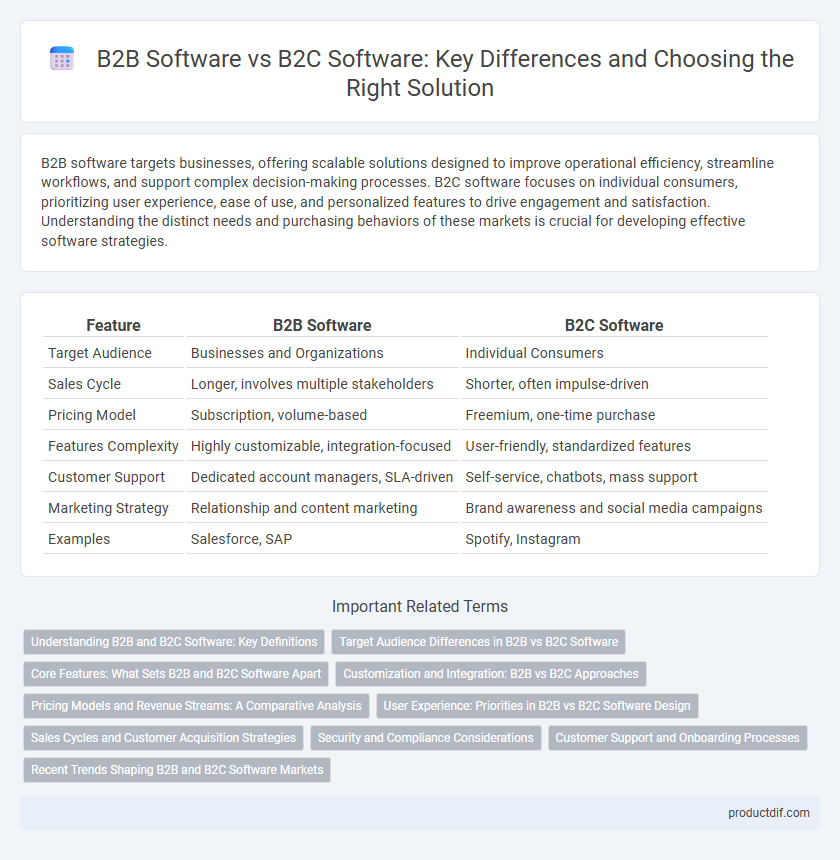B2B software targets businesses, offering scalable solutions designed to improve operational efficiency, streamline workflows, and support complex decision-making processes. B2C software focuses on individual consumers, prioritizing user experience, ease of use, and personalized features to drive engagement and satisfaction. Understanding the distinct needs and purchasing behaviors of these markets is crucial for developing effective software strategies.
Table of Comparison
| Feature | B2B Software | B2C Software |
|---|---|---|
| Target Audience | Businesses and Organizations | Individual Consumers |
| Sales Cycle | Longer, involves multiple stakeholders | Shorter, often impulse-driven |
| Pricing Model | Subscription, volume-based | Freemium, one-time purchase |
| Features Complexity | Highly customizable, integration-focused | User-friendly, standardized features |
| Customer Support | Dedicated account managers, SLA-driven | Self-service, chatbots, mass support |
| Marketing Strategy | Relationship and content marketing | Brand awareness and social media campaigns |
| Examples | Salesforce, SAP | Spotify, Instagram |
Understanding B2B and B2C Software: Key Definitions
B2B software is designed to meet the complex operational needs of businesses, focusing on efficiency, scalability, and integration with existing enterprise systems. In contrast, B2C software prioritizes user experience and accessibility, targeting individual consumers with features that enhance engagement and ease of use. Understanding these definitions helps differentiate the custom requirements, development processes, and marketing strategies unique to each software type.
Target Audience Differences in B2B vs B2C Software
B2B software targets businesses and organizations, emphasizing features that support complex workflows, scalability, and integration with existing enterprise systems. B2C software focuses on individual consumers, prioritizing ease of use, intuitive interfaces, and quick accessibility to enhance user engagement and satisfaction. Understanding these distinct target audiences is crucial for developing tailored functionalities and marketing strategies in software development.
Core Features: What Sets B2B and B2C Software Apart
B2B software emphasizes robust integration capabilities, advanced security protocols, and customizable workflows to meet complex organizational needs, while B2C software prioritizes user-friendly interfaces, seamless onboarding, and scalability for mass adoption. B2B solutions often include detailed reporting, multi-user access, and support for diverse business processes, in contrast to B2C products which focus on personalization and high engagement metrics. The core distinction lies in B2B software optimizing efficiency and collaboration for enterprises, whereas B2C software targets intuitive user experiences and consumer behavior analysis.
Customization and Integration: B2B vs B2C Approaches
B2B software emphasizes extensive customization and seamless integration with existing enterprise systems such as ERP, CRM, and supply chain management tools to meet unique business workflows and scalability requirements. In contrast, B2C software typically offers standardized features with limited customization aimed at delivering a user-friendly experience for a broad consumer base. Integration in B2C solutions often focuses on popular platforms and social media channels rather than complex enterprise ecosystems.
Pricing Models and Revenue Streams: A Comparative Analysis
B2B software pricing models often emphasize subscription-based plans, usage tiers, and enterprise licensing tailored to long-term contracts with predictable revenue streams, whereas B2C software typically relies on freemium models, in-app purchases, and one-time payments to maximize user acquisition and individual sales. Revenue generation in B2B is driven by higher average contract values and service-level agreements, contrasting with B2C's focus on volume, microtransactions, and advertising revenue. Understanding these distinctions enables software companies to optimize pricing strategies that align with customer expectations and market dynamics in their respective domains.
User Experience: Priorities in B2B vs B2C Software Design
B2B software prioritizes functionality, scalability, and integration capabilities to support complex workflows and multiple users within an organization. B2C software focuses on intuitive interfaces, personalization, and seamless accessibility to enhance user engagement and satisfaction. User experience design in B2B emphasizes efficiency and productivity, while B2C prioritizes simplicity and emotional connection.
Sales Cycles and Customer Acquisition Strategies
B2B software sales cycles are typically longer, often spanning several months due to complex decision-making processes and multiple stakeholders involved, requiring personalized demos and tailored value propositions. Customer acquisition strategies in B2B focus on relationship-building through targeted content marketing, direct sales outreach, and industry-specific trade shows or webinars. In contrast, B2C software usually has shorter sales cycles driven by impulse buying and broader market appeal, leveraging mass marketing, social media campaigns, and freemium or trial models to rapidly acquire users.
Security and Compliance Considerations
B2B software prioritizes robust security protocols and strict compliance with industry regulations such as GDPR, HIPAA, and SOC 2 to protect sensitive enterprise data and ensure regulatory adherence. B2C software focuses on securing user information with encryption standards like SSL/TLS and compliance with consumer privacy laws like CCPA, emphasizing user data protection and privacy. Enterprise-grade firewalls, multi-factor authentication, and regular security audits are critical in B2B environments, whereas B2C platforms often implement streamlined security measures to balance user experience with safety.
Customer Support and Onboarding Processes
B2B software typically offers tailored onboarding processes and dedicated customer support teams to address complex, enterprise-specific needs, ensuring seamless integration with existing systems. In contrast, B2C software emphasizes intuitive onboarding flows and scalable support solutions like chatbots or self-service resources to cater to a larger, diverse user base. Effective customer support and onboarding in both models directly impact user satisfaction and retention, making them critical components of software strategy.
Recent Trends Shaping B2B and B2C Software Markets
Recent trends in B2B software emphasize AI-driven automation, enhanced cybersecurity measures, and seamless API integrations to improve enterprise operational efficiency. B2C software is rapidly evolving with personalized user experiences powered by machine learning, augmented reality features, and subscription-based models for increased customer retention. Cloud-native architectures and low-code platforms are transforming both markets by accelerating development cycles and enabling scalable, flexible solutions.
B2B Software vs B2C Software Infographic

 productdif.com
productdif.com